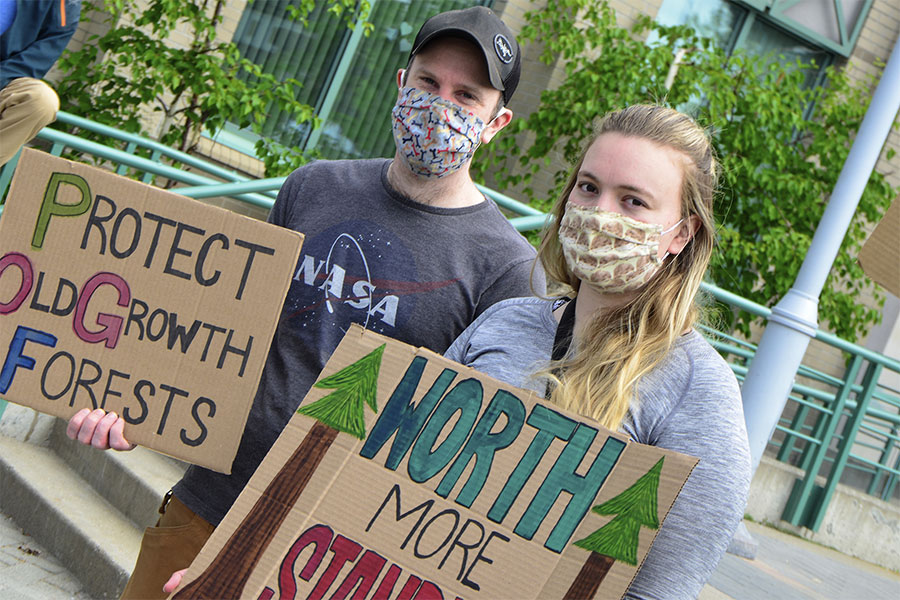Temporary Old Growth Protection for the Rainforest

Conservation North acknowledges news that the BC government will defer logging in some at-risk old growth forests in the Prince George TSA but warns that land use planning allows decision-makers to offload their responsibility for biodiversity.
Prince George, BC – Conservationists in northern BC are expecting the province’s Ministry of Forests, Lands, Natural Resource Operations, and Rural Development (FLNRORD) to temporarily defer industrial logging in some of the most at-risk old growth in the Prince George Timber Supply Area (TSA).
“These deferrals will be temporary, but they will buy some desperately-needed time for caribou, fisher and northern goshawk, among other struggling wildlife species,” according to Michelle Connolly of Conservation North.
FLNRORD was forced to intervene following an investigation by the Forest Practices Board (“the Board”) in 2020. The investigation was triggered by a complaint from a retired forester who observed extreme levels of logging by forest companies in endangered old growth spruce stands in the Parsnip drainage north of Prince George.
The Board concluded that biodiversity (plants and animals) is at high risk of irreversible loss in the vast majority of landscape units within the Prince George District because of industrial logging. This area includes the globally rare inland temperate and boreal rainforests.
The Board’s two recommendations to the BC government were that they a) promptly map and protect old growth where it is most threatened by logging, and b) update the province’s anachronistic biodiversity requirements to reflect the latest science.
In response, FLNRORD has released a statement that they will temporarily defer logging in some high-risk old growth areas in the Prince George TSA (which they call “spatializing”) in accordance with 2004 biodiversity guidelines. However, FLNRORD will not update the biodiversity guidelines to reflect the latest science, saying they will rely instead on land use planning over the next three years to determine the fate of remaining vulnerable old growth forests in the TSA.
Current requirements around biodiversity for the TSA are contained in the Biodiversity Order (“the Order”), a document that was negotiated with industry 17 years ago. “The Order is widely known to have been written to protect logging company access to the amount of old forest they want, where they want it,” explains Michelle Connolly of Conservation North. “It specifies minimum areas to be retained that are way below what the science says must be protected to avoid ecological collapse.”
The current Order allows licensees to get away with leaving as little as 26% of endangered old growth spruce forests behind after they log, when naturally 70% of these spruce forest landscapes would be old. “That’s why the Board recommended that the Order be updated,” according to outreach coordinator Jenn Matthews.
“We are relieved that something is happening to slow biodiversity loss in our region, but we need to protect all old growth now for long-term ecological resilience, not just set aside a minimum amount,” states field director Sean O’Rourke. “Decisions on biodiversity should be guided by science and traditional knowledge, not industry. We have high expectations of our government.”
The northern conservation group views land use planning as an offloading of responsibility by decision-makers. “It turns what ought to be a decision based on science and ethics into one based on politics and power,” according to Michelle Connolly.
“If you want to plan in the future you need to preserve all options now. Companies could log everything that is not temporarily deferred in the 3 three-year time period given, and then we will be planning for ecological collapse instead of community stability,” explains Michelle Connolly.
Conservation North notes that there are other serious problems with biodiversity protection in the PG TSA that were never addressed in the 2020 Board investigation report. One example is that the work of keeping track of what has been logged and how much old growth remains in the TSA is left to a group of logging companies, as opposed to an independent scientific body or BC government staff. Conservation North views this arrangement as a serious conflict of interest that needs to be rectified if there is to be any hope of protecting nature in our region.
